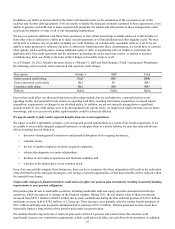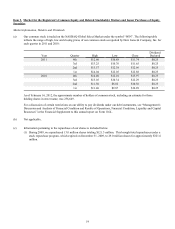Windstream 2011 Annual Report Download - page 86
Download and view the complete annual report
Please find page 86 of the 2011 Windstream annual report below. You can navigate through the pages in the report by either clicking on the pages listed below, or by using the keyword search tool below to find specific information within the annual report.14
Alternatively, we may choose to implement network management practices to reduce the network capacity available to
bandwith-intensive activities during certain times in market areas experiencing congestion, and these actions could negatively
affect customer experience and increase customer churn.
While we believe demand for these services may drive high-speed Internet customers to pay for faster broadband speeds, we
may not be able to recover the costs of the necessary network investments. This could result in an adverse impact to our results
of operations and financial condition.
We are subject to various forms of regulation from the Federal Communications Commission (“FCC”) and state regulatory
commissions in the states in which we operate, which limit our pricing flexibility for regulated voice and high-speed Internet
products, subject us to service quality, service reporting and other obligations and expose us to the reduction of revenue
from changes to the universal service fund or the intercarrier compensation system.
As of December 31, 2011, we had operating authority from each of the 48 states and the District of Columbia in which we
conducted local service operations, and we are subject to various forms of regulation from the regulatory commissions in each
of these areas as well as from the FCC. State regulatory commissions have jurisdiction over local and intrastate services
including, to some extent, the rates that we charge and service quality standards. The FCC has primary jurisdiction over
interstate services including the rates that we charge other telecommunications companies that use our network and other issues
related to interstate service. These regulations restrict our ability to adjust rates to reflect market conditions and affect our
ability to compete and respond to changing industry conditions.
Future revenues, costs, and capital investment in our wireline business could be adversely affected by material changes to these
regulations, including, but not limited to, changes in rules governing intercarrier compensation, state and federal USF support
and other pricing and requirements. Federal and state communications laws may be amended in the future, and other laws may
affect our business. In addition, certain laws and regulations applicable to us and our competitors may be, and have been,
challenged in the courts and could be changed at any time. We cannot predict future developments or changes to the regulatory
environment or the impact such developments or changes would have.
In addition, these regulations could create significant compliance costs for us. Delays in obtaining certifications and regulatory
approvals could cause us to incur substantial legal and administrative expenses, and conditions imposed in connection with
such approvals could adversely affect the rates that we are able to charge our customers. Our business also may be affected by
legislation and regulation imposing new or greater obligations related to assisting law enforcement, bolstering homeland
security, protecting intellectual property rights of third parties, minimizing environmental impacts, or addressing other issues
that affect our business. For example, existing provisions of the Communications Assistance for Law Enforcement Act require
communications carriers to ensure that their equipment, facilities, and services are able to facilitate authorized electronic
surveillance. Our compliance costs could increase if future legislation, regulations or orders continue to increase our
obligations.
Competitors, especially cable television companies, in our consumer markets are subject to less stringent industry
regulations, which could result in access line and revenues losses in the future.
Cable television companies are generally subject to less stringent regulations than our consumer operations. Cable voice
offerings and others are subject to fewer service quality and reporting requirements than our consumer operations, and their
rates are generally not subject to regulation, unlike our consumer voice services. Our consumer areas are also subject to “carrier
of last resort” obligations, which generally obligate us to provide basic voice services to any person within our service area
regardless of the profitability of the customer. Our competitors in these areas are not subject to such requirements.
Because of these regulatory disparities, we have less flexibility in our consumer markets than our competitors. This could result
in accelerated access line and revenue losses in the future.
Different interpretation and/or implementation of certain sections contained in the FCC’s Intercarrier Compensation and
Universal Service reform order could result in additional access revenue reductions.
The order provides that intrastate traffic that originates in VoIP format and is delivered by long distance carriers to us for
termination will be assessed interstate access charges. We will coordinate with the long distance carriers to determine the
amount of traffic that will be subject to the reduced interstate access rates.
Some parties are claiming that the Order provides that intrastate traffic we originate through the traditional telephone network
and deliver to a customer served under a VoIP platform is subject to interstate access charges. We believe under the Order that
such traffic continues to be subject to intrastate access charges. If the FCC determines that intrastate traffic delivered to a VoIP
























